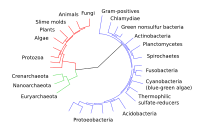
Evomics Conference and a Paper by Carl Woese

The Evomics workshop is taking place in Cesky Krumlov. If you are interested, please follow twitter hashtag #evomics2014 or check their website/blog for useful bioinformatics training material (h/t: @pathogenomenick). If this new omics word is unfamiliar to you, it is a combination of “evolution and genomics”. The current workshop is on genomics, whereas another workshop on molecular evolution will be held in 2015.
The readers of this blog are familiar with ‘genomics’, but what exactly is ‘molecular evolution’? We are not looking for the technical definition (quite apparent from the name of our blog), but rather the scientific truth being pursued through the efforts. After all, when the word ‘evolution’ is introduced, we are beyond the domain of engineering (practical tools being built on clearly defined theories) and in the domain of science (fuzzy theories seeking discovery and explanation). Let us explain.
In a paper titled - A New Biology for a New Century, legendary molecular biologist Carl Woese wrote: (h/t: ecodevoevo blog)
Science is impelled by two main factors, technological advance and a guiding vision (overview). A properly balanced relationship between the two is key to the successful development of a science: without the proper technological advances the road ahead is blocked. Without a guiding vision there is no road ahead; the science becomes an engineering discipline, concerned with temporal practical problems. In its heyday the representation that came to dominate and define 20th century biology, molecular biology, was a rich and inspiring blend of the two. By the end of the 20th century, however, the molecular vision of biology had in essence been realized; what it could see of the master plan of the living world had been seen, leaving only the details to be filled in. How else could one rationalize the strange claim by some of the world’s leading molecular biologists (among others) that the human genome (a medically inspired problem) is the Holy Grail of biology? What a stunning example of a biology that operates from an engineering perspective, a biology that has no genuine guiding vision!
The entire paper is worth reading, but here are a few thought-provoking sections from the paper -
In questioning the doctrine of common descent, one necessarily questions the universal phylogenetic tree. That compelling tree image resides deep in our representation of biology. But the tree is no more than a graphical device; it is not some a priori form that nature imposes upon the evolutionary process. It is not a matter of whether your data are consistent with a tree, but whether tree topology is a useful way to represent your data. Ordinarily it is, of course, but the universal tree is no ordinary tree, and its root no ordinary root (61). Under conditions of extreme HGT, there is no (organismal) tree. Evolution is basically reticulate.
or,
The root of the universal tree is an artifact resulting from forcing the evolutionary course into tree representation when that representation is inappropriate (60). In the pre-Darwinian era the evolutionary course cannot be represented by an organismal tree topology. It is only after a more advanced stage in cellular evolution has been reached that tree representation begins to become useful. That stage is the Darwinian threshold, the critical point before which HGT dominates the evolutionary dynamic and after which it does notthus allowing stable organismal genealogies to emerge.
Also, please check the timely discussion held by ecodevoevo blog today.
Clearly, Woese wasn’t averse to finding uncertainty where others didn’t, challenging accepted wisdom. And, that’s what he did in his discussion of the state of biology in 2004 – molecular biology as he saw it was too reductionist and too reliant on technology, and thus, in danger of focusing too closely not even on the trees, but on twigs on trees, or perhaps xylem and phloem. His view was that it was becoming impossible to see the larger picture. Or as he put it, “molecular biology could read notes in the score, but it couldn’t hear the music.”
According to Woese, 19th century biology faced two separate challenges – understanding the gene and the cell, and understanding evolution and the nature of development and the organizational structure of organisms. The first tasks could be, and were attacked in a reductionist way, by the corollary of the view in physics that reality only existed at the atomic level, and consisted of the interaction of atoms and whatever forces made that happen. Using technology, then – microscopes, PCR machines and DNA sequencers – we learned a tremendous amount about genes and cells. Cells were the reduced units of organs, and genes of cells, and understanding would be found at those reduced levels.